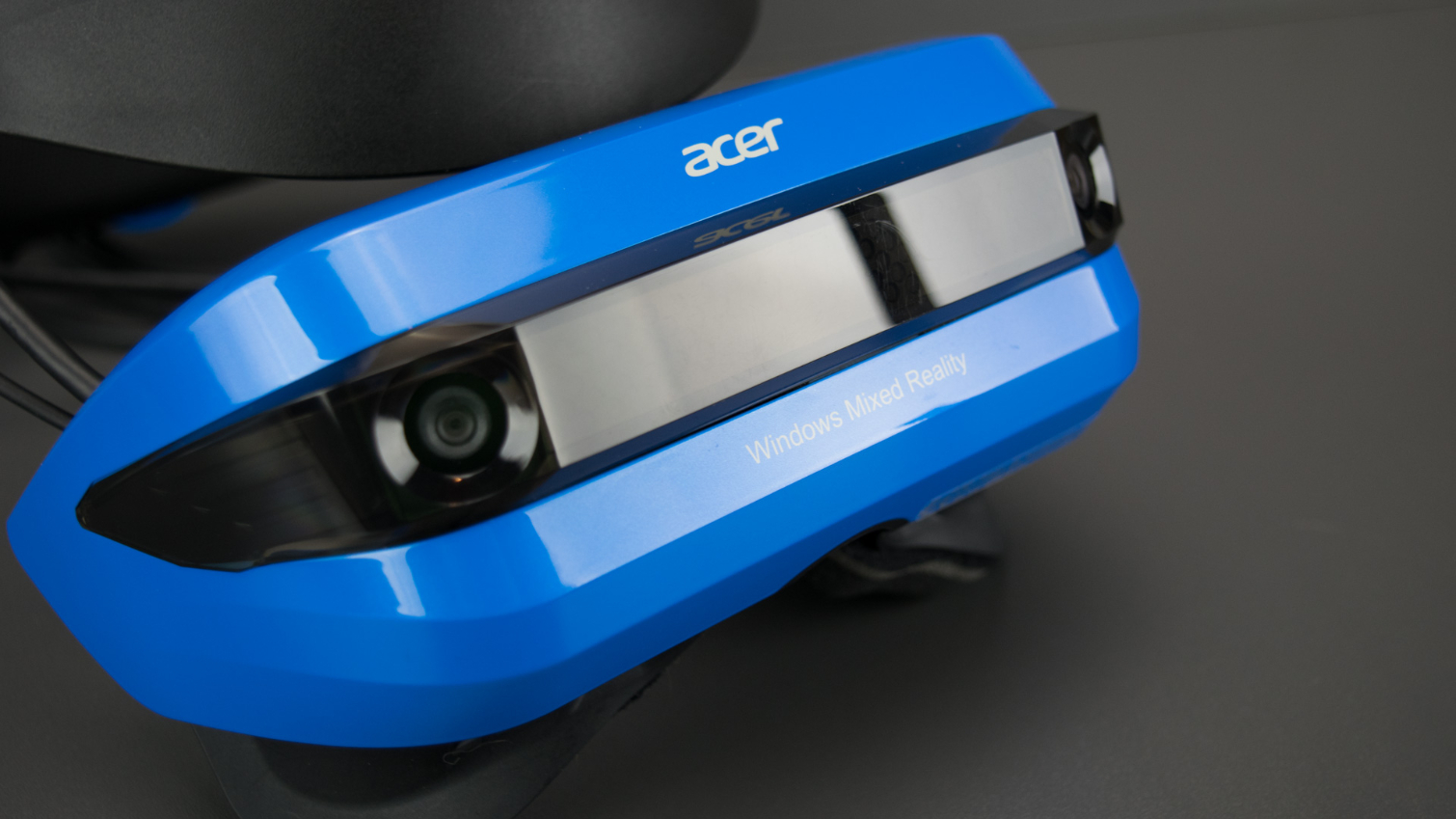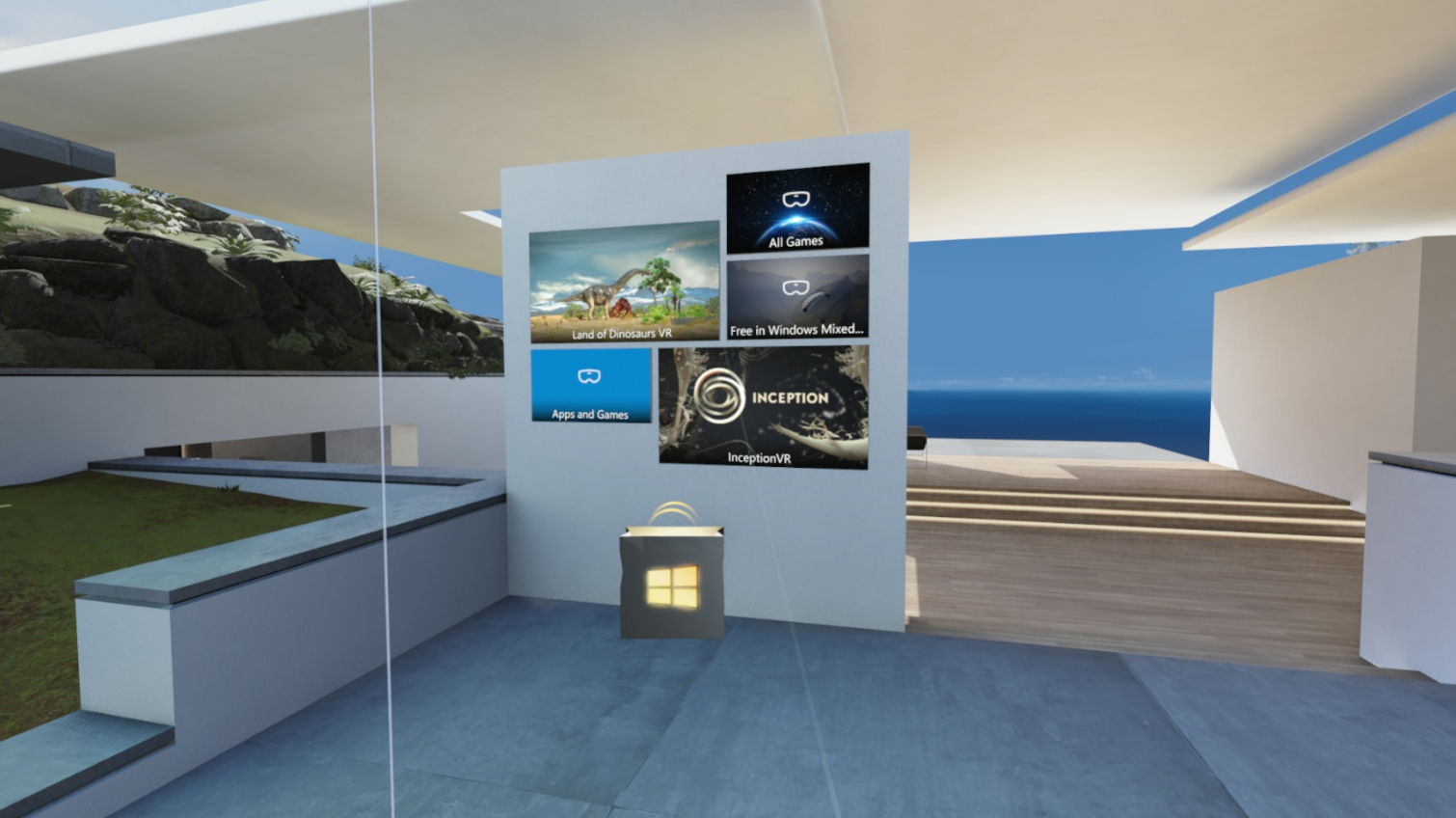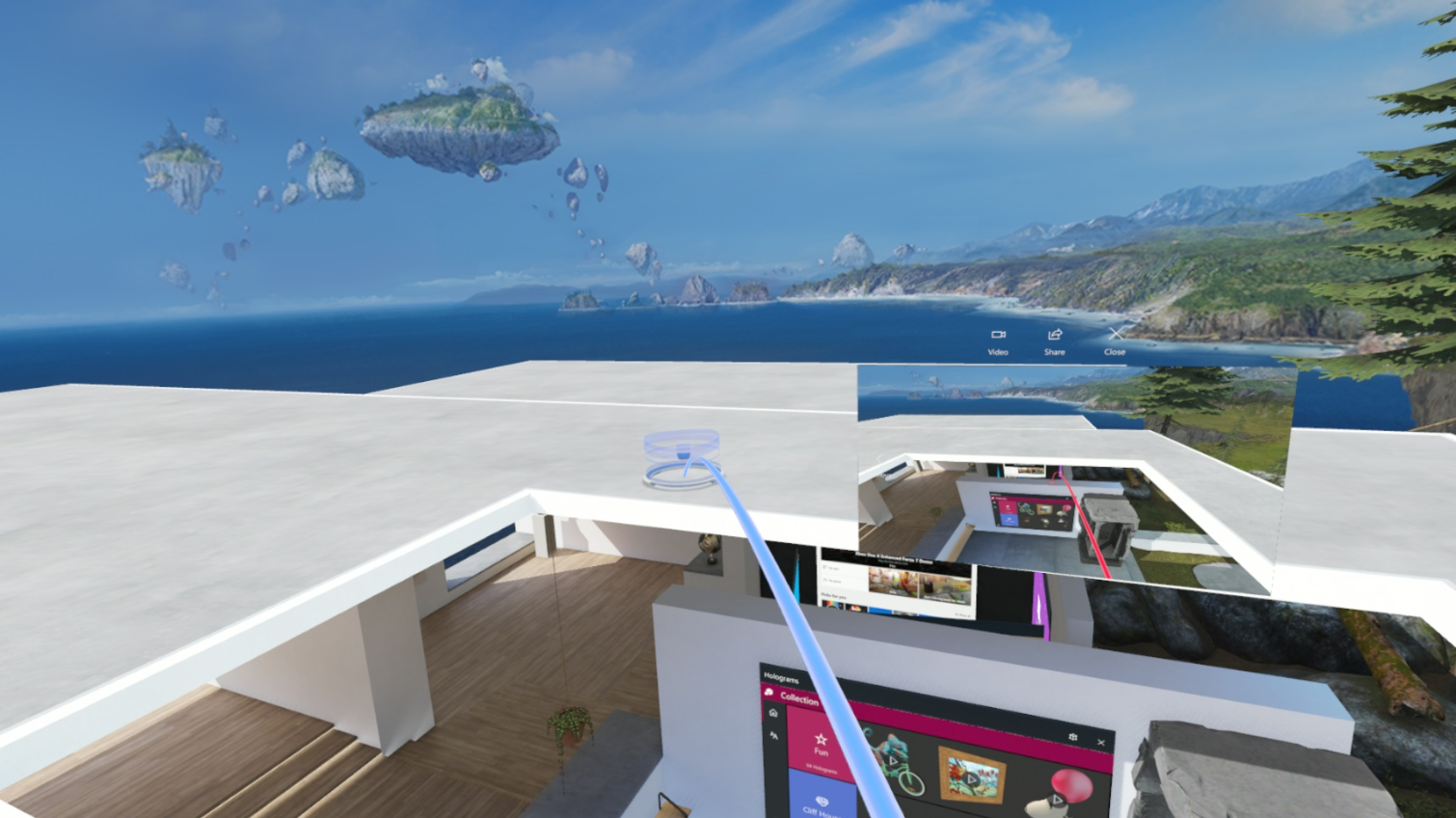Early Verdict
Acer’s Windows Mixed Reality headset is the first of the Windows MR HMDs that we’ve had a chance to explore in detail. The Acer headset features crisp, high-resolution displays, and it comes in a nice lightweight package. However, the construction of the headset leaves something to be desired. If convenient setup is more important to you than high-caliber build quality, Acer’s headset is a good introduction into VR, especially if you can get one at a discounted price.
Pros
- +
Lightweight
- +
Easy setup
- +
Crisp display
- +
Inside-out tracking system - no external cameras
Cons
- -
Build quality feels fragile
- -
Windows MR lacks minimum system requirements
- -
Poor ergonomics – controllers
- -
Poor tracking – controllers
Why you can trust Tom's Hardware
Microsoft’s Windows Mixed Reality Platform
Microsoft jumped into virtual reality last October with the formal launch of its Windows 10 Fall Creators Update, which includes the Windows Mixed Reality (WMR) platform. Although Microsoft took its time getting there, the company does see VR as a serious computing revolution, not just an enthusiast fad.
More than 18 months after Oculus and HTC began shipping Rift and Vive headsets (early 2016), Microsoft is playing fast follower and focusing on making easier, more user-friendly solutions. For example, the company invested in creating a reliable inside-out tracking system to eliminate the need for external cameras and reduce setup complexity. Microsoft also wanted its immersive computing platform to support a wide variety of applications and use cases. Today, the Windows Mixed Reality platform supports both augmented reality and virtual reality devices.
Of course, Microsoft had its first kick at the can in 2016 with the HoloLens development kit, an augmented reality device featuring inside-out tracking. The HoloLens is too expensive for regular consumer use, but it's worth noting that the system does support Windows Mixed Reality and UWP apps. Moreover, Microsoft was able to re-purpose the HoloLens tracking technology for its more affordable VR headsets.
Rather than designing a proprietary headset for the Windows Mixed Reality platform, Microsoft partnered with a half-dozen familiar hardware companies to create compatible devices, including Acer, Asus, Dell, Lenovo, Samsung, and HP. Most of the Windows Mixed Reality headsets were announced the same day as Microsoft's Windows 10 Fall Creators Update, but Acer was the first WMR partner to provide a headset for testing, so that's where we'll start our comparison of how WMR stacks up against the established Rift and Vive.
Beach House
Microsoft calls its sole Windows Mixed Reality environment the Beach House. Eventually, you'll be able to change the default environment, but this is it for now. As with the SteamVR and Oculus Home environments, Beach House is the primary hub from which you can launch apps and games.
Inside the Beach House, you’ll find a handful of rooms that are configurable for different use cases. You start outside on what can be described as the patio. On the ground in front of you, there's a bag with the Windows logo on it. When you select the bag, windows open with quick links that take you to the apps, games, and free content available for Windows Mixed Reality.
On the right-hand side, you’ll find a giant window to access the Microsoft Holograms app, which hosts items for customizing and decorating your virtual space. Some of the Holograms are static objects, such as pictures for the wall and plants for a window sill. Other Holograms are animated, and you can place the holograms anywhere in your Beach House, resized to taste.
Get Tom's Hardware's best news and in-depth reviews, straight to your inbox.
Navigation & Locomotion
You move around in the Beach House by teleporting. This involves pressing the thumbstick forward to activate the teleport reticle and using your motion controller to place the reticle on your landing spot. Simply let go of the thumbstick to teleport. You can also change orientation as you teleport by pointing the thumbstick in the direction you'd like to face when you land.
Microsoft’s locomotion mechanics draw from Cloudhead Games’ Blink system. But unlike Blink, Microsoft’s teleport system doesn’t fade the screen as you move. Instead, the field of view shrinks in to help reduce the potential for motion sickness.
MORE: Best Virtual Reality Headsets
MORE: All Virtual Reality Content
MORE: Virtual Reality Basics
Current page: Microsoft’s Windows Mixed Reality Platform
Next Page The Acer Windows Mixed Reality HeadsetKevin Carbotte is a contributing writer for Tom's Hardware who primarily covers VR and AR hardware. He has been writing for us for more than four years.
-
steve15180 I realize the article has a certain lead time. However, when the price dropped like a rock on these headsets last week, that changed the whole conclusion of the article. Is itReply
really that difficult in an online publication to update pricing before publishing? Not
the first time I've seen pricing off on these articles. -
jpe1701 I have the HP hmd and I really like it. Are all of the controllers the same for wmr? Mine fit my hand well but as you say they don't inspire much confidence that they will last.Reply -
kcarbotte Reply20647180 said:I realize the article has a certain lead time. However, when the price dropped like a rock on these headsets last week, that changed the whole conclusion of the article. Is it
really that difficult in an online publication to update pricing before publishing? Not
the first time I've seen pricing off on these articles.
The price didn't drop. Amazon is selling them at a huge discount, but if you look at Microsoft's website the price hasn't dropped for any of them.
https://www.microsoft.com/en-us/windows/windows-mixed-reality -
Sakkura Reply20649878 said:20647180 said:I realize the article has a certain lead time. However, when the price dropped like a rock on these headsets last week, that changed the whole conclusion of the article. Is it
really that difficult in an online publication to update pricing before publishing? Not
the first time I've seen pricing off on these articles.
The price didn't drop. Amazon is selling them at a huge discount, but if you look at Microsoft's website the price hasn't dropped for any of them.
https://www.microsoft.com/en-us/windows/windows-mixed-reality
Amazon is a much bigger store than Microsoft. And this is not the first time the price has dropped either. $400 is just a technicality, the practical price for the headset is under $300 (as are the other Windows MR headset, apart from the much better Samsung Odyssey model).
On another note, I think you should have put more emphasis on the lack of integrated audio. You're forced to fiddle with a separate audio headset, with its own extra cord flopping around, and often physically interfering with the VR headset. It's really a major downside compared to the Samsung Odyssey, Oculus Rift, and Vive + deluxe headstrap upgrade. -
cryoburner Reply
Yep, WMR headsets have been commonly available under $300 for a while. Sure, the MSRP might not have officially dropped, but the headsets from Acer, Dell, Lenovo and HP are all available in this price range online. In fact, some have gone on sale for under $250 at times. The Oculus Rift getting permanently discounted to $400 has made it necessary for these headsets on a less established platform to sell for less, particularly since most of them don't do much to be distinct from one another. I'm sure the high price of graphics cards hasn't helped either. It's undoubtedly hurting sales of the Rift and Vive too, but the higher resolution of these HMDs means even higher-end hardware is required for gaming, which is undoubtedly still their main draw.20650111 said:And this is not the first time the price has dropped either. $400 is just a technicality, the practical price for the headset is under $300 (as are the other Windows MR headset, apart from the much better Samsung Odyssey model).
It might be worth at least mentioning in the conclusion that it may be possible to find the headsets for well under retail. That could change of course, if adoption of the platform were to really pick up, but I think the main thing selling them currently is their lower price. -
SWKerr This is a pretty weak review especially considering that it is months after release. The cost of the actual Windows MR headsets has been between $200-300 for more than a month. Not mentioning this fact makes the conclusion misleading at best.Reply
I find it odd that you did not delve into the fact the Windows store has very few games and that you really need to use the Steam store for gaming. (Which is what 95% of people want these things for.) It would have been very helpful had you talked about this and mention some potential game compatibility limitations. Personally I have found the MR headsets work very well for every game I have tried but since they are not written for MR you are often looking at a Vive controller and guessing about how controls are mapped.
Having used all available VR headsets at this point, I actually like the Windows MR the best. It is about the ease of setup. You do not end up with a bunch of wires running everywhere for the tracking and unless you have a large dedicated room for VR this is a big deal. The tracking may not be quite as good as a perfect setup of the competitors but it is functionally really good.
Video cards: VR reviews should mention the current state of decent video cards at this time. These things will be very disappointing on anything less than a GTX 1060 6GB or RX 580 8GB. But...getting you hands on one is unlikely at any reasonable price point.
Controllers: The reference controller could be better ergonomically but they are not uncomfortable to use for long periods of time. (Samsung actually made a better version for their headset combo.) What I find nice about the controller is that becase they have both the touch pad and stick inputs you can generally play both Vive and Rift games. The controllers are interchangeable across all the headsets and I expect someone to come out with a better aftermarket controller at some point.
Really the Windows MR headsets are a good entry point for VR. They would not be good value at $399 but they are nowhere close to that price point. -
kcarbotte Reply20651505 said:This is a pretty weak review especially considering that it is months after release. The cost of the actual Windows MR headsets has been between $200-300 for more than a month. Not mentioning this fact makes the conclusion misleading at best.
I find it odd that you did not delve into the fact the Windows store has very few games and that you really need to use the Steam store for gaming. (Which is what 95% of people want these things for.) It would have been very helpful had you talked about this and mention some potential game compatibility limitations. Personally I have found the MR headsets work very well for every game I have tried but since they are not written for MR you are often looking at a Vive controller and guessing about how controls are mapped.
Having used all available VR headsets at this point, I actually like the Windows MR the best. It is about the ease of setup. You do not end up with a bunch of wires running everywhere for the tracking and unless you have a large dedicated room for VR this is a big deal. The tracking may not be quite as good as a perfect setup of the competitors but it is functionally really good.
Video cards: VR reviews should mention the current state of decent video cards at this time. These things will be very disappointing on anything less than a GTX 1060 6GB or RX 580 8GB. But...getting you hands on one is unlikely at any reasonable price point.
Controllers: The reference controller could be better ergonomically but they are not uncomfortable to use for long periods of time. (Samsung actually made a better version for their headset combo.) What I find nice about the controller is that becase they have both the touch pad and stick inputs you can generally play both Vive and Rift games. The controllers are interchangeable across all the headsets and I expect someone to come out with a better aftermarket controller at some point.
Really the Windows MR headsets are a good entry point for VR. They would not be good value at $399 but they are nowhere close to that price point.
"This is a pretty weak review especially considering that it is months after release."
I'm sorry you feel that way. I'm not going to get into the politics behind the delay in publishing, but the review was written before Christmas.
"The cost of the actual Windows MR headsets has been between $200-300 for more than a month."
Amazon is the only place that I've seen the headset discounted. Acer did no drop the price, and Microsoft didn't step in to subsidize the cost.
When the price comes down at all retailers, we'll update the review. Until then, I stand by what I wrote. Acer wants $400 for the package, and unless you buy from Amazon, that's what you'll pay.
"I find it odd that you did not delve into the fact the Windows store has very few games and that you really need to use the Steam store for gaming."
Page 8 discusses that briefly. What would you suggest should be added?
"Video cards: VR reviews should mention the current state of decent video cards at this time."
We have written a lot about the current state of the graphics card market. I don't believe that has any place in a VR review because it's a temporary state of the market. Yes, it sucks to buy into VR right now because of GPU prices, but that doesn't affect the merit of the headset itself, nor the platform it runs on.
"Controllers: The reference controller could be better ergonomically but they are not uncomfortable to use for long periods of time."
Maybe for you, but my hands cramped up within 10 minutes of using them, and several people who tried it had similar complaints. Not everyone will have that problem, but the controllers were not designed in such a way that most people won't have problems.
As for the Samsung controllers-- I haven't received a sample from Samsung yet, so I can't say much about that. I used Samsung's controllers for about 10 minutes and they are much better ergonomically. -
Heliosurge Reguarding no integrated audio; have you considered one of the many wireless headset options? Many bluetooth ones also require no headband.Reply
Steam? Did you miss the "Early Access support" support in steam. Or the fact that if you are a steam user; we would see a new headset icon that represents WMR.
Reviews usually go with suggested retail price not a retailer's sale. Now i do agree that a small addition mentioning that Amazon is having a sale on them.
But all in all a great review! -
Heliosurge KevinReply
While Intel's igpu peeformane was not good are you able to run some tests on Amd's Apus? Fm2+ & Ryzen Apus would be interesting if they yeild better results.


